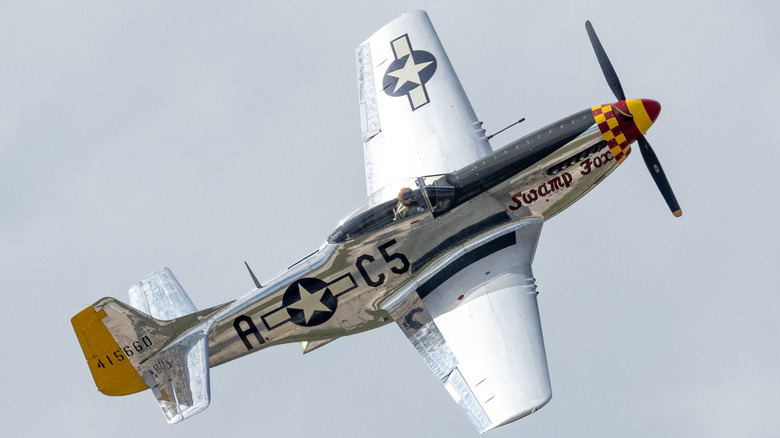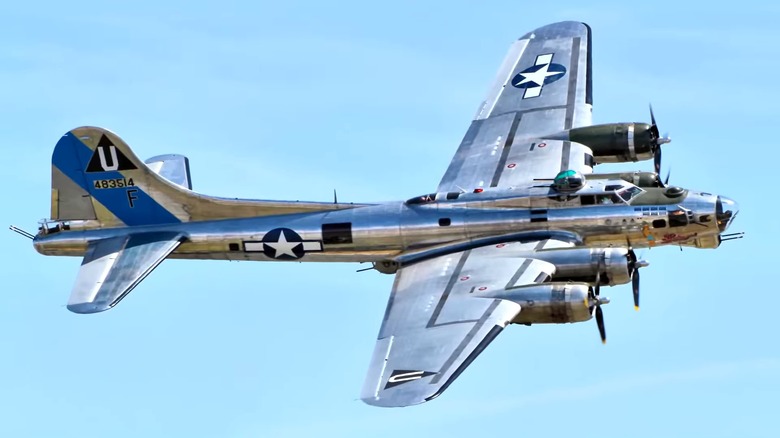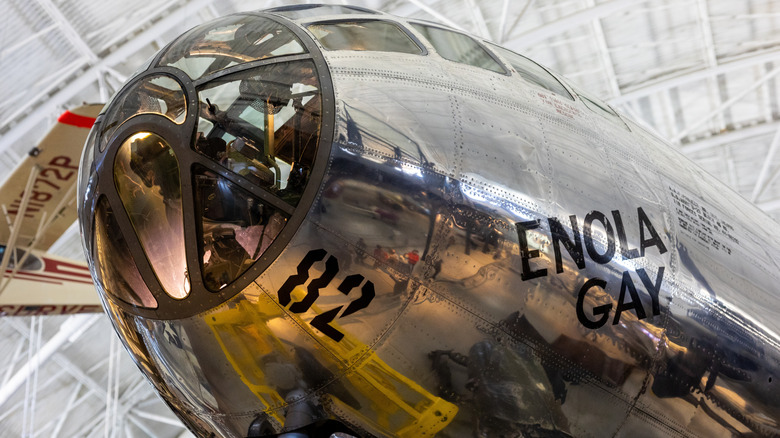Why Many US WW2 Planes Used In Battle Were Left Shiny, Silver & Unpainted
Most people know about camouflage and how important it is in keeping military equipment and personnel safe. Troops wear camoflage, and there are many different types. It's also important to disguise materiel, which can come in all sorts of patterns and designs. Back in World War I, it wasn't uncommon for the Navy to use incredibly unusual zazzle patterns, though this is no longer the case. And hiding aircraft was also important, especially during WWII.
It wasn't uncommon to paint the bottom of an aircraft blue or white to blend in with the sky. Conversely, the tops of planes would often be painted green or brown, depending on the area in which they operated. That all makes sense, but there's something about American aircraft used during the latter half of WWII that defies logic because many of them were unpainted, shiny, and clearly made of metal. This didn't disguise the aircraft in any way, and it's likely the lack of pain had the opposite effect, but the Americans didn't care.
There are several reasons why the U.S. stopped painting its aircraft during the war, but the primary reason is air superiority. In any conflict, attaining air superiority offers several advantages, including uncontested airspace. Without enemy aircraft to cause problems, it became unnecessary to paint the planes, so many were left shiny. By not painting the military aircraft, they were easier to spot, but they also lacked the additional weight and cost associated with paint. The aircraft operated more efficiently.
Air superiority was the key
Today, many military aircraft and ships are painted gray, but this wasn't always the case. Initially, military planes sported all kinds of colors, mostly meant to disguise them while on the ground. Colors also helped to identify aircraft in the sky, as IFF (Identify Friend or Foe) systems weren't installed on all aircraft. When the U.S. entered the war, Europe was still very much in Germany's hands. The conflict raged on for years, and, by 1944, the Allies attained air superiority. This was accomplished via multiple campaigns designed to limit wartime production, disrupt supply lines, and destroy factories.
With the ability to operate mostly uncontested, those who designed and built aircraft came to realize that paint wasn't necessary. It's easy to discount paint as not adding much weight to a plane, but it takes a lot to coat an aircraft, especially if it's something massive like a bomber. Modern passenger planes have between 600 and 1,200 lbs. of paint added to them, and this changes how a plane operates. It increases weight, which forces the aircraft to burn more fuel than it would otherwise need.
Removing the paint eliminates this issue, it reduced production time, and it made the aircraft more effective, though there were some downsides. Paint offers a layer of protection, which is the main reason it's used in modern planes and also back during WWII. Maintaining the metal without paint required a great deal of attention. Still, the benefits outweighed the detrimental factors, and by the end of WWII, the U.S. had stopped painting most of its aircraft operating in Europe as well as in the Pacific theater.
The most famous silver plane of WWII
By the end of the war, it wasn't uncommon to see something like a B-17 Flying Fortress or the iconic and legendary P-51 Mustang sport a mirror shine metal finish. While these aircraft are representative of the practice of not painting WWII aircraft, they're not the most famous examples. That distinction lies with a special B-29 Superfortress named the Enola Gay. The Enola Gay holds an important, though horrific, place in history, as it's the aircraft that dropped the bomb on Hiroshima, Japan.
Like in Europe, the Americans established air superiority so they could fly unpainted planes, especially when they had important missions. The Enola Gay was part of the plan to end the war as quickly as possible. She flew into Japanese airspace and dropped the bomb, but she wasn't your average B-29. The Enola Gay was known as a "Silverplate," which was a specially modified B-29 designed specifically for the atomic bomb mission.
The plane needed to feature an increased performance envelope, as it had to survive the close-range detonation and radiation while managing to film the whole thing. Killing the paint job and using the specialized metal plating helped to ensure Enola Gay's survival. You can see the plane herself today. She's on permanent display at the Air & Space Museum's Udvar-Hazy Center in Chantilly, Virginia, and is a perfect example of an unpainted WWII plane.


